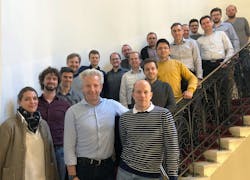Photonic chip in development to enable mobile ophthalmic OCT
The Medical University of Vienna (Vienna, Austria) is leading a European research project in which engineers and scientists are developing a handheld device for mobile ophthalmic care based on low-cost and miniaturized photonic chip technology. The novel photonic integrated technology is expected to bring optical coherence tomography (OCT) from stationary clinical use to broader, mobile use in ophthalmic care.
Over the next five years, the research team consisting of engineers and scientists from European research institutions and from industry will be developing a handheld ophthalmic imaging device for mobile, low-cost OCT. It is based on novel photonic integrated technology and will be tested together with medical doctors from Vienna General Hospital.
The goal is to enable point-of-care applications of a well-established imaging modality for the diagnosis and treatment monitoring of important eye diseases such as age-related macular degeneration (AMD), diabetic retinopathy (DR), and glaucoma that are together the worldwide leading cause for blindness. This is achieved by dramatically reducing the size of the diagnostic device and reducing fabrication costs while at the same time increasing the usability and performance of OCT technology for broad applicability. It is expected that this technological jump will improve ophthalmic care, in particular point-of-care diagnostics and diagnostic-driven therapy, and reduce the burden to the healthcare systems at the same time.
The Medical University of Vienna is leading the project “Handheld optical coherence tomography (HandheldOCT),” which consists of a consortium with seven partners from four European countries. The project has been awarded a grant of EUR6 million (over $6.4 million) from Horizon 2020, the EU program for research and innovation.
To evaluate the potential and the usability of the mobile technology, it will be developed jointly in the consortium and assessed by medical doctors and scientists of the Medical University Vienna for benchmarking. The successful evaluation in an established medical application will open the door to OCT’s broad mobile use for 'in-the-field' care and point-of-care, and in the clinical praxis.
The project comprises researchers from one university, two research institutions, and four companies. The technological core of the project, the integrated photonic chip, is designed by researchers from AIT and imec and processed in imec’s CMOS Pilot Line. The chip’s packaging and interface adaption are realized by researchers from Tyndall National Institute, which includes the at-chip microfabrication of freeform optics developed by Nanoscribe (Karlsruhe, Germany). Researchers from Innolume develop a novel akinetically tunable light source, representing another key component of the technology. The packaged photonic chip and the light source are integrated in a handheld ophthalmic prototype system developed and realized by Carl Zeiss with support by researchers from the Medical University Vienna. The handheld system requires a high degree of integration and miniaturization of all the optics, mechanics and electronics, meeting the conditions for its clinical evaluation at the Medical University.
